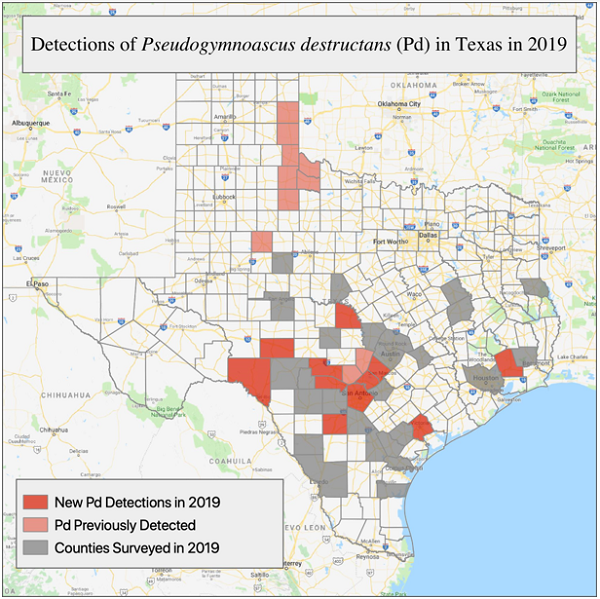Commission Agenda Item No. 12
Presenter:
Jonah Evans
Briefing
White-Nose Syndrome
August 22, 2019
I. Executive Summary: Pseudogymnoascus destructans (Pd), the fungus that causes White-Nose Syndrome (WNS) in bats continues to spread in Texas. Texas Parks and Wildlife Department (TPWD) staff will present details and discuss plans for addressing the disease.
II. Discussion: Since the discovery of White-Nose Syndrome in New York State in 2006, over six million bats have perished as the disease has spread through the eastern United States and Canada.
In early 2017, Pd was detected in Texas for the first time by TPWD-funded research projects with Texas A&M University and Bat Conservation International. In 2018, Pd was found in Central Texas in Kendall and Blanco counties. This year, there was a significant increase in detections in and around Central Texas. The fungus has now been detected in a total of 21 Texas counties, up from just 10 last year. The fungus was also detected at Bracken Bat Cave, the largest bat roost in the world. While the Mexican free-tailed bats that roost at the site are not expected to be susceptible to WNS, researchers are concerned that their large migrations may help spread the disease further into the western United States or into Mexico. Frio County now contains the southernmost detection of the fungus in the United States.
No signs of WNS, the disease caused by the fungus, have been reported in Texas to date. It usually takes a few years after detecting the fungus for the disease to manifest. Of the 33 species in Texas, seven have been documented with WNS in other states. While susceptibility of many of the species found in Texas is currently unknown, we expect that at least nine species are at risk from the disease.
The four species of bats have been found carrying Pd in Texas are the tri-colored bat (Perimyotis subflavus), the cave myotis (Myotis velifer), the Townsend’s big-eared bat (Corynorhinus townsendii), and the Mexican free-tailed bat (Tadarida brasiliensis).
In January, TPWD was awarded a grant by the National Fish and Wildlife Foundation to conduct experimental treatments on tri-colored bats at several large roost sites in culverts in East Texas. The first treatments will begin this summer. TPWD is also in the process of hiring a bat biologist for a two-year position to assist with WNS surveillance and research efforts. Finally, TPWD recently funded a multi-year statewide summer acoustic monitoring effort led by researchers at Texas State.
Commission Agenda Item No. 12
Exhibit A
Map of Pseudogymnoascus destructans (Pd) Detections in Texas
